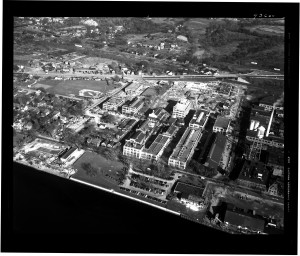
Again from the Fairchild Aerial Surveys collection of the New York State Archives. This time, a 1946 view of what is described as the Bayer Aspirin Factory, Riverside Avenue, Rensselaer. But what we’re actually looking at may be a little more complicated than that.
A paper by Leander Ricard, posted at ColorantsHistory.org, gives the history of the dye industry in scenic Rensselaer, which went back a long way. When it was written in 1994, there was still some dye-making going on at the site, but its heyday was long past.
According to Ricard, the business started on Hamilton Street in Albany in 1868, when cardboard maker A. Bott branched out into colorants and formed the Albany Aniline and Chemical Company. Dyes, mostly then made from coal tars and other somewhat nastier substances, weren’t entirely compatible with a residential neighborhood, and the plant was moved down to Broadway. Bott bowed out, familiar Albany names like Hendrick and Pruyn moved in, and a connection to German dye-maker Farbenfabriken of Elberfeld was established as the company got into the magenta business, which was raging at the time. A couple of imported chemists, William Loesser and Hermann Preiss, had a falling out with manager Elwood Hendrick and, with the support of Farbenfabriken vorm. Friedrich Bayer and Company, formed the Hudson River Aniline Color works in 1882 on a site across the Hudson River in Greenbush (now Rensselaer).
Hudson River Aniline made fuchsine (magenta dye) and water blues. In agreement with Bayer, the line expanded to alkali and cotton (acid) blues, then continued to grow. The plant burned in 1895 but was quickly rebuilt. In the first part of the 20th century, the plant expanded greatly, and in 1905 new buildings were dedicated to the manufacture of aspirin, for which Bayer today is most famous. In 1910, the name of the company was changed to Farbenfabriken of Elberfeld Co. and then in 1913, perhaps out of fear that their sign would collapse under the weight of all the letters, the company name was changed to The Bayer Co. When the United States entered The Great War in 1917, the company was seized as alien property and sold to a patent medicine outfit called Sterling Products, which wanted the pharmaceuticals. (Which got them involved in some early patent trolling involving another Albany company, which we’ve written about before.) The dyestuff part of the plant was sold to Cleveland’s Grasselli Chemical Company, under whose banner colorants were produced until 1928. The facility eventually landed under the name of General Aniline and Film Corp., better known as GAF, and in 1978 was bought by BASF, “Badische Anilin & Sodafabrik,” another German outfit. The history of the many buildings at the site, some of which can be seen in this view, can be found in this report by Hartgen Archaeological Associates. A brief listing of the buildings is also available here.
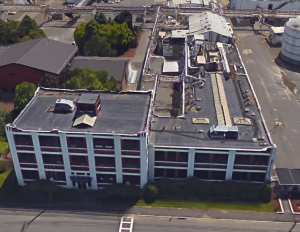 Unfortunately, there isn’t such a detailed history of the pharmaceutical buildings at the site. They are the ones that are front and center and the ones that survive today. (Others from the dye works were torn down over time, most recently to accommodate a new electric generation plant.) Sterling Winthrop continued to operate there (as well as up the hill, where their research laboratories are now part of the SUNY Albany East Campus), manufacturing aspirin and who knows what else. They owned the Bayer Aspirin name for decades; Bayer didn’t get it back until 1994, when short-term Sterling owner Eastman Kodak sold its pharmaceutical business after only six years. The research business, which Kodak valued, was in the process of being moved out of Rensselaer to Upper Providence Township, PA, when Kodak jettisoned the whole business line. The prescription side went to Sanofi, and the over-the-counter business went to SmithKline Beecham, which sold the Bayer brand back to Bayer. (Thanks to a detailed history of Sterling posted here.)
Unfortunately, there isn’t such a detailed history of the pharmaceutical buildings at the site. They are the ones that are front and center and the ones that survive today. (Others from the dye works were torn down over time, most recently to accommodate a new electric generation plant.) Sterling Winthrop continued to operate there (as well as up the hill, where their research laboratories are now part of the SUNY Albany East Campus), manufacturing aspirin and who knows what else. They owned the Bayer Aspirin name for decades; Bayer didn’t get it back until 1994, when short-term Sterling owner Eastman Kodak sold its pharmaceutical business after only six years. The research business, which Kodak valued, was in the process of being moved out of Rensselaer to Upper Providence Township, PA, when Kodak jettisoned the whole business line. The prescription side went to Sanofi, and the over-the-counter business went to SmithKline Beecham, which sold the Bayer brand back to Bayer. (Thanks to a detailed history of Sterling posted here.)
This 1989 article from the Schenectady Gazette tells the tale of the impending loss of 1,210 jobs at the East Greenbush / Rensselaer facilities, leaving 135-150 jobs in what was called Sterling Organics Manufacturing. In the Hartgen document, those buildings are primarily considered off the map, listed as “Organichem,” which today is Albany Molecular Research Inc., AMRI, an active pharmaceutical concern.
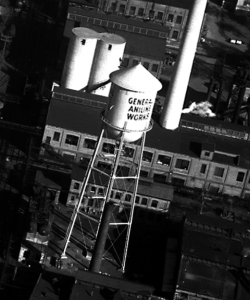
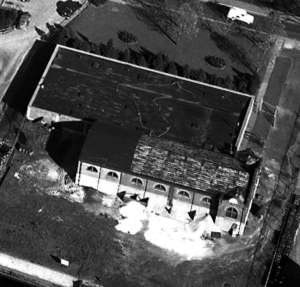
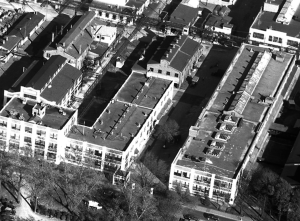
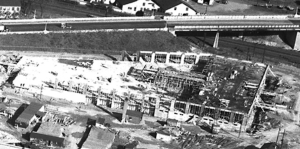
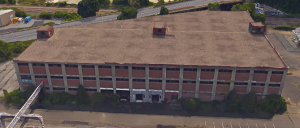
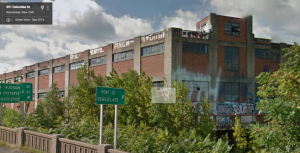
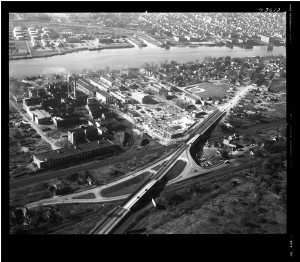
And, one last view, this time from the southeast. The road running diagonally is the Columbia Turnpike, Routes 9 & 20. At the upper end of the photo, you can see that the road turns instead of leading to the ramp for the Dunn – because then the Dunn Memorial Bridge came squarely up Third Avenue instead of having a ramp that snaked over to the turnpike. In 1946, the turnpike was lined with an even more ragtag assemblage of buildings than it is today, which is saying something. The baseball diamond and athletic fields are still there.
There’s a pair of deep cuts into the Port of Albany, across the river, just south of the Bab-O factory, that are no longer there, but the railroad siding just beyond them is still there. Much of the rest of that landscape has been changed by I-787.

Leave a Reply